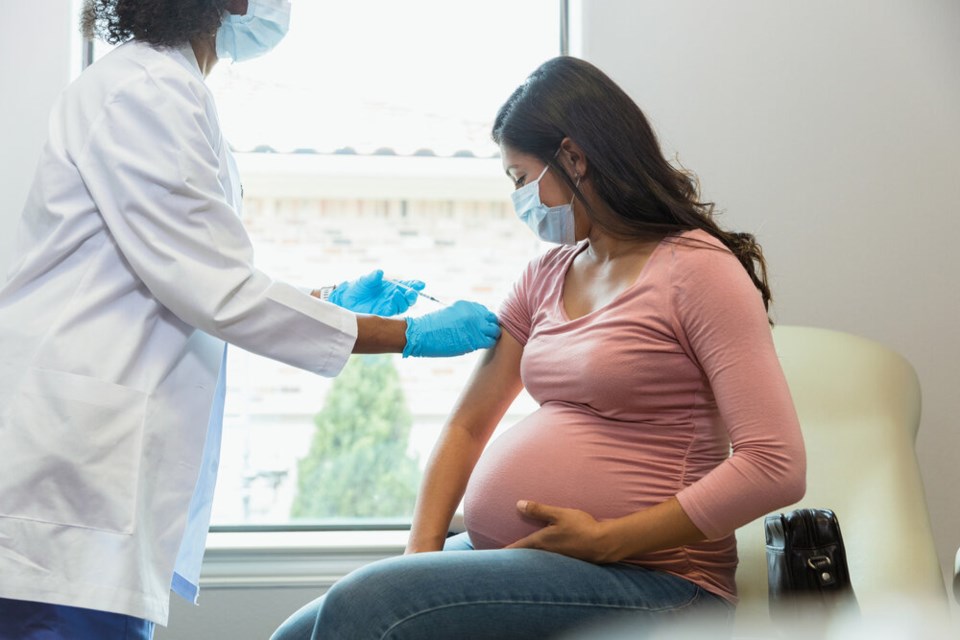Vaccination rates among pregnant British Columbians have skyrocketed over the last three years, a trend partly driven by more maternity care providers recommending women get pre-natal vaccinations.
The percentage of pregnant women vaccinated against whooping cough in B.C. more than doubled to 52.4 per cent in 2021 from 25.6 per cent in 2019, according to a report from Statistics Canada released Tuesday.
Significant gains were also made in vaccinations against influenza, with B.C.’s vaccination rate climbing to 61 per cent from 49.8 per cent over the same three-year period.
Gains in pre-natal vaccination rates were made in most provinces. Canada’s average flu vaccination rate sat at 52.7 per cent in 2021, nearly eight percentage points higher than in 2019.
But while B.C. sits well above the national average for flu vaccinations, its vaccination rate for whooping cough falls behind every other province and territory in Canada.
Whooping cough, or pertussis, is a contagious bacterial infection that affects the lungs and airways.
“Pertussis causes serious coughing fits that can lead to choking or vomiting. The coughing can be so intense that a ‘whooping’ sound happens when you try to catch your next breath,” notes the federal agency.
According to Health Canada, between 1,000 and 3,000 people get sick with it every year. Global annual infection rates climb to 40 million at times, with deaths sometimes reaching 400,000 per year.
The respiratory disease can last for months without antibiotic treatment, in some cases causing brain damage or death. Unvaccinated children under the age of one are most at risk.
Gains and gaps driven by advice from health-care providers
Nearly all the pregnant women surveyed in the Canada-wide poll were found to have a maternity care provider. In 2021, two-thirds said they had received advice to get the influenza and Tdap (tetanus, diphtheria and pertussis) vaccines, as recommended by the National Advisory Committee on Immunization.
That’s up from 49 per cent of pregnant women who, in 2019, said they had received a recommendation to get vaccinated against the whooping cough and 61 per cent who said they had received advice to get vaccinated against influenza.
“These increases in provider recommendations help explain the overall increases in vaccine coverage for pertussis and the flu that were observed in 2021,” notes StatsCan in its report.
Overall, one in 10 women said they faced delays of 30 or more days in getting vaccinated against whooping cough and the flu.
The report notes that not receiving a recommendation to get vaccinated while pregnant continues to drive low vaccination rates among some populations.
Vaccination gaps open and grow
The top reason pregnant women didn’t get pre-natal vaccinations was a lack of awareness that they were recommended by professionals.
Over the last three years, a gap in vaccination rates has sprung up between Indigenous and non-Indigenous women: 57 per cent of Indigenous women were vaccinated against whooping cough in 2021, compared with 65 per cent of non-Indigenous women.
That’s a reversal from 2019, when more Indigenous women (45 per cent) were vaccinated against the bacterial disease than non-Indigenous women (44 per cent).
Pregnant Indigenous women also fell further behind non-Indigenous women in vaccination rates against the flu.
The StatsCan report suggests some of the differences stem from more Indigenous survey respondents saying health-care providers didn’t recommend pre-natal vaccinations during visits.
“Other factors, such as differences in access to health-care providers and barriers and prejudices encountered during accessing health care, may also explain differences in vaccination coverage and recommendations,” noted the report.
Vaccination rates also showed wide differences among other racialized groups: vaccination rates against whooping cough varied from 55 per cent among Black Canadians to 72 per cent among Chinese Canadians.
A further 61 per cent of South Asian Canadians said they remembered receiving a recommendation to get their pre-natal vaccinations, compared to 72 per cent among non-Indigenous and non-racialized women.
Roughly three-quarters of women said the COVID-19 pandemic did not affect their decision to receive pre-natal vaccinations.
But for some pregnant women, the pandemic had a big affect on their decision to seek out pre-natal vaccinations.
More than any other group, 39 per cent of pregnant Filipino Canadians and 26 per cent of pregnant South Asian Canadians said the pandemic made them more inclined to get vaccinated.



